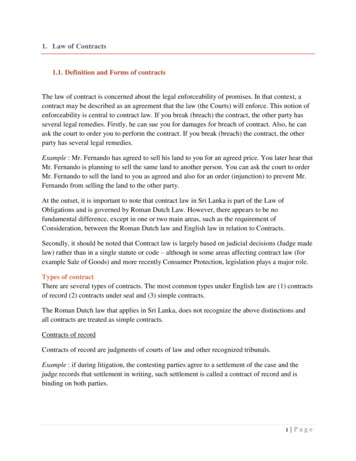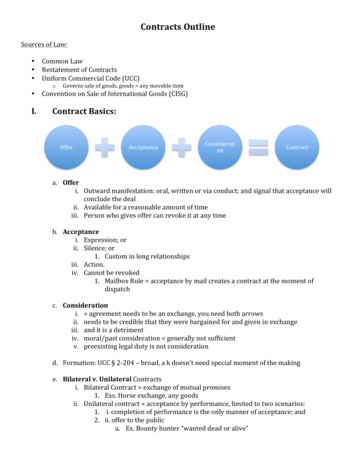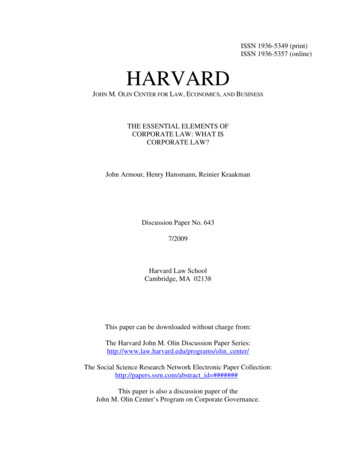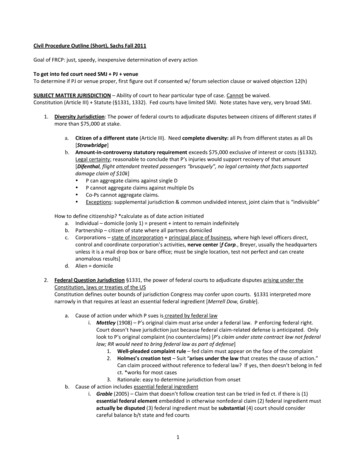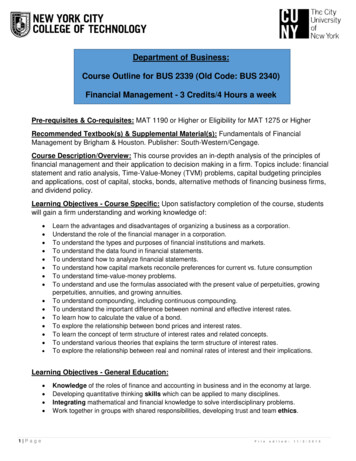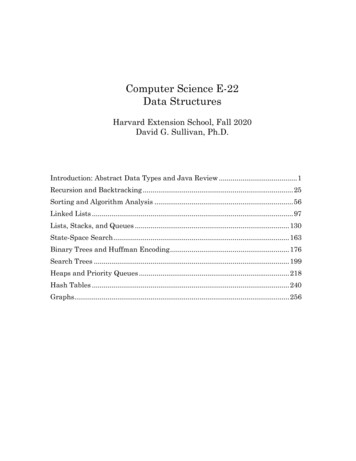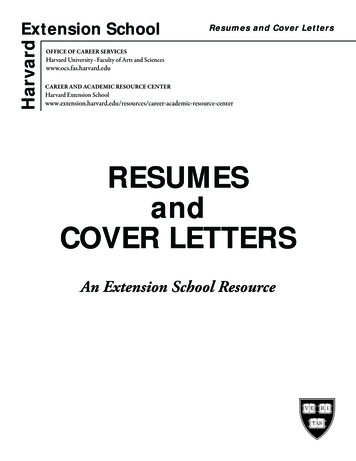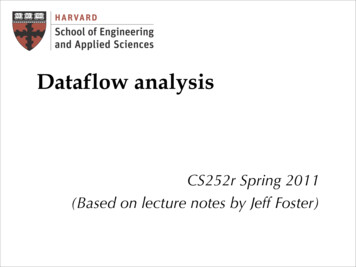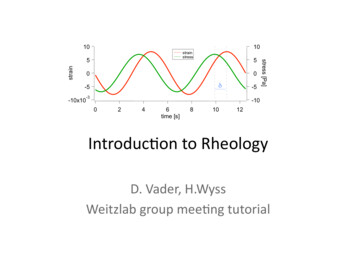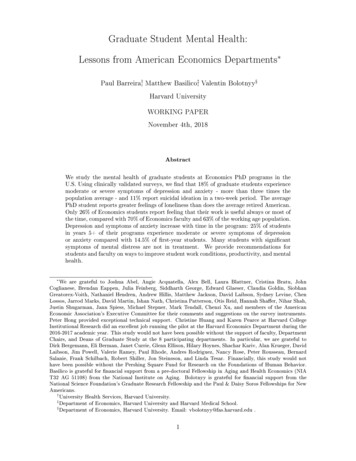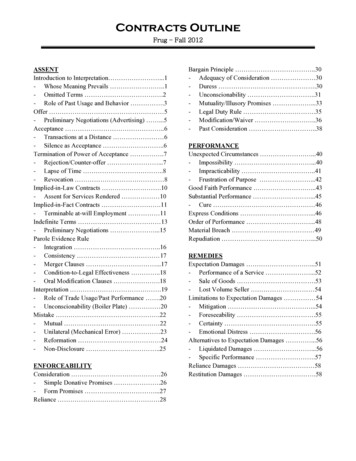
Transcription
Contracts OutlineFrug – Fall 2012ASSENTIntroduction to Interpretation .1- Whose Meaning Prevails .1- Omitted Terms .2- Role of Past Usage and Behavior .3Offer 5- Preliminary Negotiations (Advertising) .5Acceptance .6- Transactions at a Distance 6- Silence as Acceptance .6Termination of Power of Acceptance .7- Rejection/Counter-offer .7- Lapse of Time .8- Revocation 8Implied-in-Law Contracts .10- Assent for Services Rendered 10Implied-in-Fact Contracts .11- Terminable at-will Employment 11Indefinite Terms 13- Preliminary Negotiations .15Parole Evidence Rule- Integration .16- Consistency 17- Merger Clauses .17- Condition-to-Legal Effectiveness .18- Oral Modification Clauses .18Interpretation .19- Role of Trade Usage/Past Performance .20- Unconscionability (Boiler Plate) 20Mistake .22- Mutual 22- Unilateral (Mechanical Error) 23- Reformation 24- Non-Disclosure .25ENFORCEABILITYConsideration 26- Simple Donative Promises .26- Form Promises .27Reliance 28Bargain Principle .30- Adequacy of Consideration 30- Duress .30- Unconscionability .31- Mutuality/Illusory Promises .33- Legal Duty Rule .35- Modification/Waiver .36- Past Consideration .38PERFORMANCEUnexpected Circumstances .40- Impossibility .40- Impracticability .41- Frustration of Purpose .42Good Faith Performance .43Substantial Performance .45- Cure 46Express Conditions .46Order of Performance .48Material Breach 49Repudiation .50REMEDIESExpectation Damages .51- Performance of a Service .52- Sale of Goods .53- Lost Volume Seller 54Limitations to Expectation Damages 54- Mitigation .54- Foreseeability .55- Certainty .55- Emotional Distress .56Alternatives to Expectation Damages .56- Liquidated Damages .56- Specific Performance .57Reliance Damages 58Restitution Damages .58
ContractsASSENT .INTRODUCTION TO INTERPRETATIONRestatement (Second) § 201 – Whose Meaning Prevails(1) Where the parties have attached the same meaning to a promise or agreement, both parties are boundto that meaning(2) Where the parties have attached different meanings to a promise or agreement, party A’s meaning isattached if party B knew of party A’s interpretation or had reason to know of this interpretation ANDparty A did not know or did not have reason to know of party B’s interpretation (see also § 20(2))(3) Where both parties attached different meanings and neither has reason to know of the other’smeaning, then there is no assent (see also § 20(1))Whose Meaning Prevails – Common Law¾ a person’s intentions corresponds to the “reasonable meaning of his words and acts”o mental assent of the parties not requisite for the formation of a contract – outward expressionsmanifest intent and not secret thoughtso see Lucy v. Zehmer (outward drunken behavior established assent despite his secret belief it wasa joke)o see also Embry v. McKittrick (Embry reasonably interpreted his boss’s statement to constitute anextension of his employment and court upheld as a valid contract)¾ Raffles v. Wichelhaus (Peerless)o Facts – Defendant ordered cotton to be delivered by a ship called the Peerless. The cotton arrivedby another ship than he intended, also called the Peerlesso Argument for voiding the contract based on parole evidence, the ambiguity in the contract rendered it none bindingo Argument for not voiding the contract based on parole evidence, intention of defendant to want a certain ship is irrelevant unlessstates at the time of the contract does not affect the deal because delivery method was immaterial to the core contractPrinciples of Modern Interpretation¾ view interprets “reason to know” to mean that it is “more reasonable”¾ slightly different take on §§ 201 and 20 would come about(1) If the parties attach different meanings and neither party knows of the other’s meaning, then themore reasonable meaning prevails (§ 201(2)(b))(2) If the same case presents itself but the two meanings are equally reasonable then neither wins(§20(1))(3) If the parties attach the same meanings, then that meaning prevails even if unreasonable (§201(1))(4) If the parties attach different meanings BUT one party (A) knows that the other party (B) attachedanother meaning then the other meaning (B) prevails even if it less reasonable (§ 201(2))Page 1
Contractsothis view is a “fault system” where the party most at fault for the misunderstanding loses –not about meeting of the mindsRestatement (Second) § 204 – Supplying an Omitted Essential Term (Implied Terms)¾ When the parties to a bargain have entered into a sufficiently defined contract but have not agreedwith respect to an essential term then court supplies a reasonable term for the circumstances¾ Three Cases of Implied Term Contractso terms that parties had in mind but did not expresso terms parties would have expressed if the issue had been raisedo terms parties would have expressed if they had foreseen the difficultyOmitted Essential Term – Case Law¾ court provides “reasonable” duration for a contract (see Haines v. New York)o Facts – City had a contract to supply sewage for the entire city but city expanded at a faster ratethan when contract entered into. City wanted sewage plant to increase capacity to meet new needsbeyond what it was willing to handleo A contract without a fixed duration is neither terminable-at-will nor in perpetuity¾ purpose/goal underlying the contract can provide meaning to terms to apply to unexpressedcircumstanceso view that words standing alone are meaningless without contexto Spaulding v. Morse (father promised to pay son money until he went to college but son joinedmilitary instead – court found father only intended to pay if he needed the support) “If the instrument as a whole produces a conviction that a particular result was fixedlydesired although not expressed by formal words, that defect may be supplied by implicationand intention”o Lawson v. Martin Timber Co. (contract provision allowing an extra year to cut down timber ifhigh water occurred interpreted to only extend duration if high water actually prevented removal)¾ Textualism versus Purposivismo neither is necessarily correct and the same judge will often apply botho Issues with Textualism impossible and impractical for parties to dictate all conditions for every possible scenario inwritingo Issues with Purposivism typically not stated clearly in the contract so attributed to the contract by court, not the partiesPage 2
ContractsROLE OF PAST USAGE AND BEHAVIOR IN INTERPRETATIONRestatement (Second) § 221 – Usage Supplementing an Agreement¾ Condition for employing usage – each party knows or has reason to know of the usage AND neitherparty has reason to know that the other party intended an inconsistent usageo employ usage for contracts of similar type¾ similar to modern interpretation of §201(2)(b)U.C.C. § 1–201. General Definitions(3) “Agreement” as distinguished from “contract” means the bargain of the parties as found in theirlanguage or inferred from other circumstances as provided in §1-303Hierarchy of Interpretation (U.C.C. §1–303(e))¾ Express Terms Æ Course of Performance Æ Course of Dealing Æ Trade Usage¾ this preference order reflects the closest approximation to the intentions of the party and minimizescourt interference into private contractsU.C.C. § 1–303(a). Course of Performance (see also Restatment (Second) § 221)¾ A course of performance is sequence of conduct to a particular transaction between parties if:(1) the agreement involves repeated occasions for performance by a party; and(2) the other party, with an opportunity to reject and knowledge of the performance, accepts theperformance without objectionRestatement (Second) § 223 – Course of Dealing (see also U.C.C. § 1–303(b))(1) A course of dealing is a sequence of previous conduct between the parties to an agreement whichfairly establishes a common basis of understanding for interpreting their agreement(2) Unless otherwise agreed, course of dealing is to be used to give meaning to an agreementCourse of Dealing – Case Law¾ Foxco Industries v. Fabric Worldo Key Facts – The dispute in this case was over the term “first quality” goods. Defendant accepteda first order that included some flaws. However, for the second order, it claimed that “firstquality” meant without a single flaw.o Uncontroverted evidence that industry custom allowed for some mistakes in “first quality.”o Statute assumed that parties to such a contract are presumed to have intended the trade usageo contrary view – parole evidence rule renders contract void because subjective intent of a partycannot provide meaning unless it informs the other party of its intention at the time of contractPage 3
ContractsRestatement (Second) § 222 – Usage of Trade (see also U.C.C. § 1–303(c))(1) An interpretation is a trade usage if it is observed with such regularity as to justify an expectationthat it will be observed with respect to a particular agreement(2) Existence and scope of trade usage to be determined as question of fact. If a usage is embodied in awritten code then interpretation is to be determined by the court as a matter of law(3) Unless otherwise agreed, trade usage is to be used to give meaning to an agreemento this clause justified trade usage coming behind course of dealing/performanceo prior behavior can indicate that parties prefer some other interpretation than general trade usageTrade Usage – Case Law¾ Frigaliment Importing Co. v. BNS Intern. Sales Corp. (contract dispute over word “chicken”)o Subjective differences in parties interpretation sorted by trade usage and reasonablenesso For trade usage to apply to parties either new to the trade or not members of the trade, it must beshown that so general known or so long in continuance that individual knowledge may beinferredo Defendant argues that by referencing Grade A chicken in the contract, it adopted the USDAregulations and definitionso if defendant’s action fit under at least one reasonable definition then the burden is on the plaintiffto show that a narrower or alternative definition was intended¾ Hurst v. W.J. Lake (court employed usage of “minimum 50% protein” of horse meat scraps industry)o courts finds it safe to believe that when a tradesmen employs a term then attach trade usage¾ EXCEPTION for parties new to the tradeo see Flower City Planning v. Gumina (court rejected customary local practice of paintingsubcontracting jobs meaning a contract for the entire project)o court deemed unrealistic to hold parties strictly to a “reason to know” standard of trade usageo no contract existed because two reasonable but different meanings of essential termso similar to Raffles v. Wichelhaus (neither party at fault so contract void)Page 4
ContractsOFFER AND ACCEPTANCEOFFERRestatement (Second) § 22 – Mode of Assent: Offer and Acceptance¾ the way parties ordinarily manifest mutual assent through offer and acceptanceRestatement (Second) § 24 – Offer Defined¾ An offer is the manifestation of willingness to enter into a bargain such that another person isjustified in understanding that his assent is invited and will conclude ito definition is offeree focused in that it depends on a justified understanding of another partyo there is a notion of reliance embedded in this dependencePreliminary Negotiations – Common Law (Advertisement Binding)¾ test of a binding obligation is whether “the facts show that some performance was promised inpositive terms in return for something requested” (Williston)o other examples of offer based on Williston’s view note on the back of an envelope promising a prize “just for opening” it ad stating that anyone with a 1954 car can exchange for a 1955 at no price sign at a golf course stating that a hole-in-one wins an automobile advertisements for rewards¾ Lefkowtiz v. Great Minneapolis Surplus Store (an advertisement for coats on a “first come, firstserved” basis without qualification valid offer)o Rule – an offer is typically present where the terms are concrete, definite, and not open tonegotiation (follows § 24 notion of offeree reliance)o contrary argument claims that unilateral offers void due lack consideration¾ Donovan v. RRL Corp. (state vehicle code stated that advertisements to sell a car an offer)o specific statute trumps black-letter ruleRestatement (Second) § 26 – Preliminary Negotiations¾ A manifestation of willingness is not an offer if the person to whom it is address knows or has reasonto know that the person making it does not intend to conclude a bargain without further manifestationof assentPreliminary Negotiations – Common Law (Advertisement NOT Binding)¾ generally accepted black-letter rule for advertisement simply identifying goods and specifying aprice is only an invitation to negotiation¾ Lonergan v. Scolnicko Key Facts – Defendant placed a form letter in the paper advertising land for sale. Plaintiff sentdefendant a letter letting him know that he was proceeding with details to purchase land butdefendant had already sold it to another party.o Holding – No contract offer conditioned on prompt acceptancePage 5
Contracts intentions clear from correspondence that negotiations “purely preliminary”x “decide fast” language suggests that further expression of assent necessary¾ Regent Li
extension of his employment and court upheld as a valid contract) ¾ Raffles v. Wichelhaus (Peerless) o Facts – Defendant ordered cotton to be delivered by a ship called the Peerless. The cotton arrived by another ship than he intended, also called the Peerless o Argument for voiding the contract
